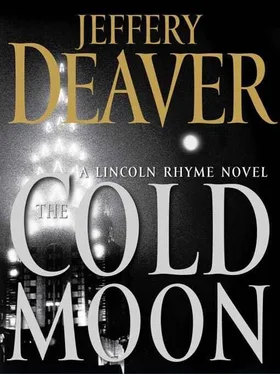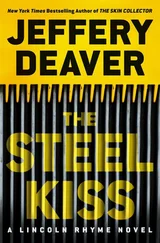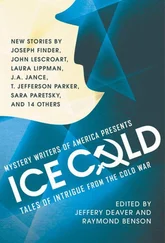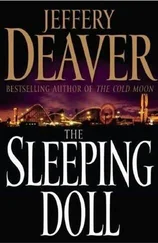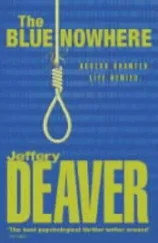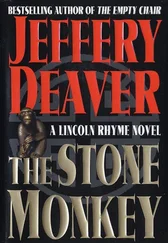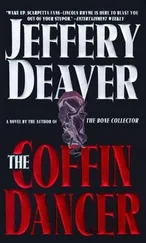"And Vincent?" Duncan continued. "I made sure he never got close enough to any women to hurt them. I'm the one who turned him in. I called nine-one-one and reported him. I can prove it." He gave details about where and when the rapist was caught-which confirmed that he'd been the one who called the police.
The prosecutor looked like he needed a time-out. He glanced at his notes, then at Duncan, and rubbed his shiny head. His ears were bright red from the cold. "I've gotta talk to the district attorney about this one." He turned to two detectives from Police Plaza who'd met him here. The prosecutor nodded at Duncan and said, "Take him downtown. And keep somebody on him close-remember, he's diming out crooked cops. People could be gunning for him."
Duncan was helped to his feet.
Amelia Sachs asked, "Why didn't you just come to us and tell us what happened? Or make a tape of Baker admitting what he'd done? You could've avoided this whole charade."
Duncan gave a harsh laugh. "And who could I trust? Who could I send a tape to? How did I know who was honest and who was working with Baker?…It's a fact of life, you know."
"What's that?"
"Corrupt cops."
Rhyme noticed Sachs gave absolutely no reaction to this comment, as two uniformed officers led their perp, such as he was, to a squad car.

They were, at least temporarily, once again a team.
You and me, Sachs…
Lincoln Rhyme's case had become Amelia Sachs's and if the Watchmaker had turned out to be toothless there was still a lot of work left to do. The corruption scandal at the 118th house was now "front-burnered," as Sellitto said (prompting Rhyme's sardonic comment, "Now there's a verb you don't hear every day"). Benjamin Creeley's and Frank Sarkowski's killer or killers had yet to be identified specifically from among the cops who were suspected of complicity. And the case against Baker had to be cobbled together and the Maryland connection-and the extortion money-unearthed.
Kathryn Dance volunteered to interview Baker but he was refusing to say a word so the team had to rely on traditional crime scene and investigative work.
On Rhyme's instruction, Pulaski was cross-referencing Baker's phone calls and poring over his records and Palm Pilot, trying to find out whom he spent the most time with at the 118th and elsewhere but wasn't coming up with anything helpful. Mel Cooper and Sachs were analyzing evidence from Baker's car, house on Long Island and office at One Police Plaza, as well as the houses or apartments of several girlfriends he'd been dating recently (none of whom knew about the others, it turned out). Sachs had searched with her typical diligence and had returned to Rhyme's with cartons of clothes, tools, checkbooks, documents, photos, weapons and trace from his tire treads.
After an hour of looking over all of this, Cooper announced, "Ah. Got something."
"What?" Rhyme asked.
Sachs told him, "Found some ash in the clothes that were in the trunk of Baker's car."
"And?" Sellitto asked.
Cooper added, "Identical to the ash found in the fireplace at Creeley's. Places him at that scene."
They also found a fiber from Baker's garage that matched the rope used in Benjamin Creeley's "suicide."
"I want to link Baker to Sarkowski's death too," Rhyme said. "Get Nancy Simpson and Frank Rettig out to Queens, that place where his body was found. Take some soil samples. We might be able to place Baker or one of his buddies there too."
"The soil I found at Creeley's, in front of the fireplace," Sachs pointed out, "had chemicals in it-like from a factory site. It might match."
"Good."
Sellitto called Crime Scene in Queens and ordered the collection.
Sachs and Cooper also found samples of sand and some vegetation that turned out to be seaweed. These substances were found in Baker's car. And there were similar samples in his garage at home.
"Sand and seaweed," Rhyme commented. "Could be a summer house-Maryland, again. Maybe Baker's got one, or a girlfriend of his."
But a check of the real estate databases showed that this wasn't the case.
Sachs wheeled in the other whiteboard from Rhyme's exercise room and she jotted the latest evidence. Clearly frustrated, she stood back and stared at the notations.
"The Maryland connection," she said. "We've got to find it. If they killed two people, and nearly Ron and me, they're willing to kill more. They know we're closing them up and they won't want any witnesses. And they're probably destroying evidence right now."
Sachs was silent. She looked flustered.
It's hard when your lover is also your professional partner. But Lincoln Rhyme couldn't hold back, even-especially-with Amelia Sachs. He said in a low, even voice, "This's your case, Sachs. You've been living it. I haven't. Where does it all point?"
"I don't know." She dug a thumbnail into her finger. Her mouth tight, she shook her head, staring at the evidence chart. Loose ends. "There's not enough evidence."
"There's never enough evidence," Rhyme reminded. "But that's not an excuse. That's what we're here for, Sachs. We're the ones who examine a few dirty bricks and figure out what the entire castle looked like."
"I don't know."
"I can't help you, Sachs. You've got to figure this one out on your own. Think about what you've got. Somebody with a connection to Maryland…somebody following you in a Mercedes…saltwater and seaweed…cash, a lot of cash. Crooked cops."
"I don't know ," she repeated stridently.
But he wasn't giving an inch. "That's not an option. You have to know."
She glared at him-and at the hard message beneath the words, which was: You can walk out that door tomorrow and throw away your career if you want. But for now you're still a cop with a job to do.
Her fingernails worried her scalp.
"There's something more, something you're missing," Rhyme muttered as he too gazed at the evidence charts.
"So, you're saying we have to think outside the box," said Ron Pulaski.
"Ah, clichés," Rhyme snapped. "Well, okay, if you're in a box, maybe you're there for a reason. I say don't think outside it; I say look more closely at what's inside with you… So, Sachs, what do you see in there?"
She stared at the charts for some moments.
Then she smiled and whispered, "Maryland."
BENJAMIN CREELEY HOMICIDE
56-year-old Creeley, apparently suicide by hanging. Clothesline. But had broken thumb, couldn't tie noose.
Computer-written suicide note about depression. But appeared not to be suicidally depressed, no history of mental/emotional problems.
Around Thanksgiving two men broke into his house and possibly burned evidence. White men, but faces not observed. One bigger than other. They were inside for about an hour.
Evidence in Westchester house:
Broke through lock; skillful job.
Leather texture marks on fireplace tools and Creeley's desk.
Soil in front of fireplace has higher acid content than soil around house and contains pollutants. From industrial site?
Traces of burned cocaine in fireplace.
Ash in fireplace.
Financial records, spreadsheet, references to millions of dollars.
Checking logo on documents, sending entries to forensic accountant.
Diary re: getting oil changed, haircut appointment and going to St. James Tavern.
Analysis of ash from Queens CS lab:
Logo of software used in corporate accounting.
Forensic accountant: standard executive compensation figures.
Burned because of what they revealed, or to lead investigators off?
St. James Tavern
Creeley came here several times.
Читать дальше
